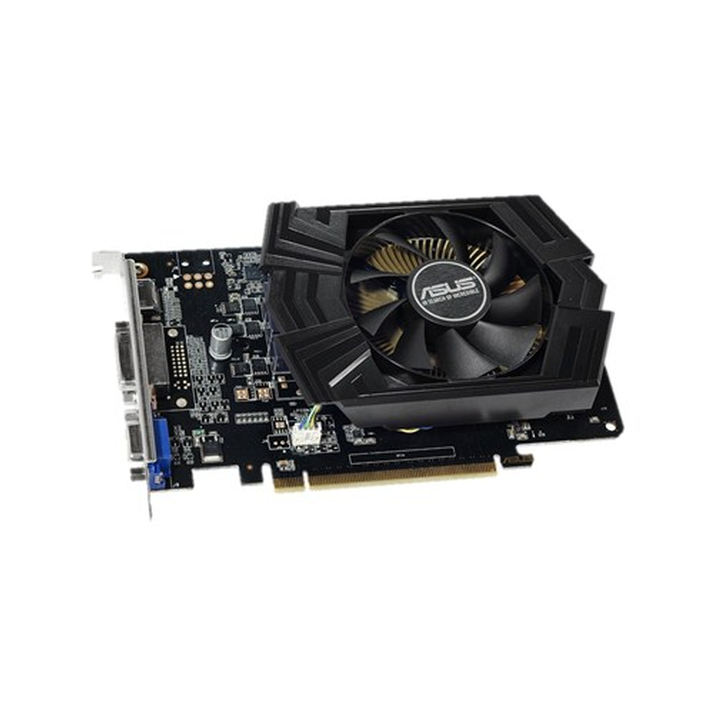Not everyone can afford nVidia or AMD’s flagship graphics cards but the good news is that you don’t need the very latest high-end card to play the latest games on your PC. We’ve already tested out three £45 graphics cards which didn’t pass muster in our tests, but what if your budget can stretch to the heady heights of £65? To find out, read our Asus GeForce GT 740 OC vs Sapphire Radeon R7 250X comparison review. See also: the best budget graphics cards At this price you’re obviously not going to be getting a top performer, but you can expect a product that isn’t ferociously cutting corners in every department. Indeed, in terms of figures, these cards seem to offer a bounty of pimped and primed specs. Perhaps the first revelation is that the GDDR3 RAM of the cheaper cards has been jettisoned in favour of ultra-fast GDDR5. These memory chips offer faster speeds, allowing the manufacturers to wring far more performance from the cards. We’re still stuck with 128-bit memory interfaces, but nowadays you’ll have to push your budget to considerably higher heights if you want a wider bus: no sub-£100 card can better that. Both graphics cards here are furnished with just 1GB of memory, which might concern some users. The extent to which you’d make use of an extra 1GB at this level of gaming is highly debatable. However, if there’s one aspect of these cards we’d like to hike if possible, it’s the amount of RAM. Both the Asus GeForce GT 740 OC and Sapphire Radeon R7 250 start with strong memory clock speeds. Whereas cheaper graphics cards are stuck on memory clocks of 800-900MHz, the Sapphire Radeon R7 250X pushes this figure out to 1125MHz. And the Asus GeForce GT 740 goes further still, hitting the heady heights of 1250MHz. And because GDDR5 is better than GDDR3 at extending the capabilities of those clocks, the difference between these and the cheaper cards becomes rather more marked when you look at the speeds the memory can ‘effectively’ achieve – 4.5GHz and 5GHz in the case of the 250X and 740 OC, as opposed to just 1.6-1.8GHz for the cheap cards. Put simply, GDDR3 doesn’t have the multiplying finesse of GDDR5. Unsurprisingly, the more expensive cards have vastly superior memory bandwidth figures, and the 250X and 740 OC can output the information at a rate of 72GB/sec and 80GB/sec respectively. Even the best of the £45 cards can only offer 28.8GB/sec, so these £65 cards will cope with greater workloads far more easily. See also: best graphics cards of 2015.
These £65 cards can also deliver more textures. The Sapphire Radeon R7 250X loses out to the 740 on memory clocks, and it also trails when it comes to core clocks – offering 950MHz in reply to the 740’s healthy 1033MHz. But here, at least, the Radeon R7 250X can fight back. That’s because it comes with 40 texture units rather than the 32 of the 740. The superior quantity of texture units means that the 250X overtakes its rival when it comes to the overall texture fill rate – scoring 38GT/sec against the 740 OC’s 33.1GT/sec – despite the 740 having a better clock rate. The £45 models, in contrast, produce paltry figures between 11.2GT/sec and 15.6GT/sec – much of this difference can be attributed to the £45 cards having far fewer texture units. The 250X strikes another victory on stream processors, its 640 far outnumbering the 384 of the GT 740 OC. In all honesty, this difference is less dramatic than it might seem at first. The AMD architecture has tended to produce rather more stream processors on average than the nVidia equivalent. This has often not translated into superior performance, so we should take this with a pinch of salt. Both cards are fairly equal in terms of ports and connectors. Both have DVI and HDMI, although the 250X also comes with a DisplayPort outlet. This particular 740, in contrast, comes with VGA. Both cards require a single 6pin connector from the PSU, although the 250X puts out considerably more power, offering a TDP of 95 watts against the GeForce GTX 750’s 60 watts. In practise, the difference between the two was around 20 watts, but the 750 is clearly a more efficient and power-conservative card.
Asus GeForce GT 740 OC vs Sapphire Radeon R7 250X: Benchmark results
Unlike cheaper graphics cards, the Asus GeForce GT 740 OC and Sapphire Radeon R7 250 effortlessly shatter the 30fps mark at a resolution of 1680×1050. Crucially, they’re never far away from the 50fps. If you’re getting close to 50fps, you should be having a very comfortable playing experience. Both cards struggle at 1920×1080, but if you really want to play at that resolution, you’ll probably need to increase your budget. As to which of the two is better, the R7 250X makes great use of its superior texture handling, and notches up comfortable wins across the board, generally defeating the GT 740 OC by 4-5fps. Both of these cards are decent for gaming, though, and can turn their hands to strong multi-display setups as well. See also: best graphics cards of 2015.


